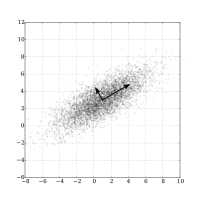
Photo from wikipedia
Background: Quantitative analysis of the active ingredients of Traditional Chinese Medicine is a research tendency. The objective of this study was to build a novel method, namely, Detection-confirmation-standardization-quantification (DCSQ), for… Click to show full abstract
Background: Quantitative analysis of the active ingredients of Traditional Chinese Medicine is a research tendency. The objective of this study was to build a novel method, namely, Detection-confirmation-standardization-quantification (DCSQ), for the quantitative analysis of active components in traditional Chinese medicines, without individual reference standard. Methods: Danshen (the dried root of Radix Salvia miltiorrhiza) was used as the matrix. The “extraction” function in high-performance liquid chromatographymass (HPLC-MS) instrument was used to find the peaks corresponding to cryptotanshinone, tanshinone I, and tanshinone IIA in the total ion current (TIC) chromatogram of Danshen. The multicomponent reference standard (MCRS) containing the three tanshinones mainly was prepared by preparative HPLC. The contents of them in the resulting MCRS were determined by NMR; moreover, the constituents of the MCRS were confirmed. The MCRS containing known content of the three tanshinones was used as the reference standard for the quantitative analysis of cryptotanshinone, tanshinone I and tanshinone IIA in Danshen Samples by analytical HPLC. Results: The optimized HPLC conditions for the quantitative analysis of the active components in Danshen were established, and the assignments of the extracted peaks were confirmed by analyzing the characteristic fragments in their MS/MS product ion spectra and UV spectra. Then, the MCRS containing the three tanshinones were successfully prepared. The results of determination about the contents by NMR showed linearity fitted with high likelihood and calibration curves possessed high linearity. The results of determination on Danshen Samples obtained through DCSQ exhibited minimal deviations, in contrast to those obtained through individual reference standards. Conclusion: The establishing DCSQ is independent and convenient for the quantitative analysis of the active components in TCMs by MCRS, without individual reference standard. This method is a great advance in quantitative analysis for complex composition, especially TCMs. How to cite this article Song X, Zhao A, Liu Y, Cheng J, Chen S, Liu A. 2021. Detection-confirmation-standardization-quantification: a novel method for the quantitative analysis of active components in traditional Chinese medicines. PeerJ Analytical Chemistry 3:e10 DOI 10.7717/peerj-achem.10 Submitted 26 November 2020 Accepted 24 February 2021 Published 29 April 2021 Corresponding authors Sha Chen, [email protected] An Liu, [email protected] Academic editor Julia Martín Additional Information and Declarations can be found on page 14 DOI 10.7717/peerj-achem.10 Copyright 2021 Song et al. Distributed under Creative Commons CC-BY 4.0 Subjects Analytical Chemistry (other), Mass Spectrometry, NMR Spectroscopy, Novel Analytical Technologies, Spectroscopic Analysis
Journal Title: PeerJ
Year Published: 2021
Link to full text (if available)
Share on Social Media: Sign Up to like & get
recommendations!